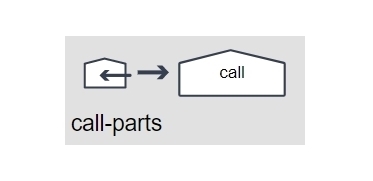Call Node

Description
A call node is a system-facing step that allows you to connect logicnets together.
Use
By creating logicnets that focus on a particular function or series of actions you enable your logicnet designs to be more modular and reusable. You can connect your logicnets together using a call node. When someone is running through your application and reaches a call node the system "jumps" to the connected logicnet. The system either returns to the original logicnet after reaching the end of the connected one or moves to another connected logicnet, depending on how the nodes are connected.
Editor Fields
| Field Name | Description/Use | Type/Options | Optional/Mandatory |
| Library project | When another project is configured as a library, it is selectable here and that enables public logicnets in that library project to be selected (using the ellipsis) in the Logicnet to call field. For more information on library projects, go to the support article called Libraries. | Text | Optional |
| Logicnet to call | This is the name of the logicnet that will be called at this step in the overall pathway. | Text | Mandatory |
| Context path | Putting a "container" name here will mean all variables created within the called logicnet will be stored in the context within this container, and NOT in the global context. | Text | Optional |
| Collection | Repeating forms use this field to name the array in which all the form data is stored. Go to the Tab Control support article for more information. | Collection | Optional |
| Class | This field can be used to access style settings to be applied to any UI within the called logicnet. It is also used automatically by the repeating form functionality. | Text | Optional |
Visual Example

Advanced Use
Call nodes play an important part in four substantial areas of functionality used in many LogicNets applications. Separate support articles have been written for these topics.
- Many UI-heavy applications have some need for repeated input -- forms that collect the same types of data for different objects (e.g. locations, products) Download and import the project ASF How-To Guide - Repeating Inputs for more information on this.
- Libraries can house common logicnets for use across multiple applications. See Libraries for more information.
- Functions are logicnets that take input parameters, go through a user-defined process, and issue output variables. The system calls them with a Call Node that shows an additional Parameters tab where you can enter the specific values to be used in the function. See Functions for more information.
- Collapsible sections can be used to hide or show sections of information to the user, and make best use of the available space on screen. See Collapsible Sections and check out the example project.
Reply
Content aside
- 3 yrs agoLast active
- 298Views
-
2
Following
